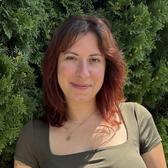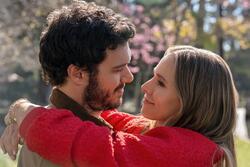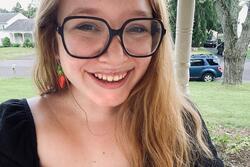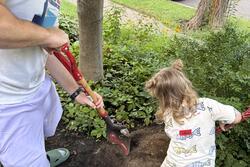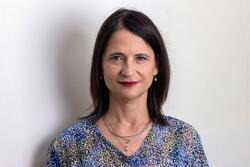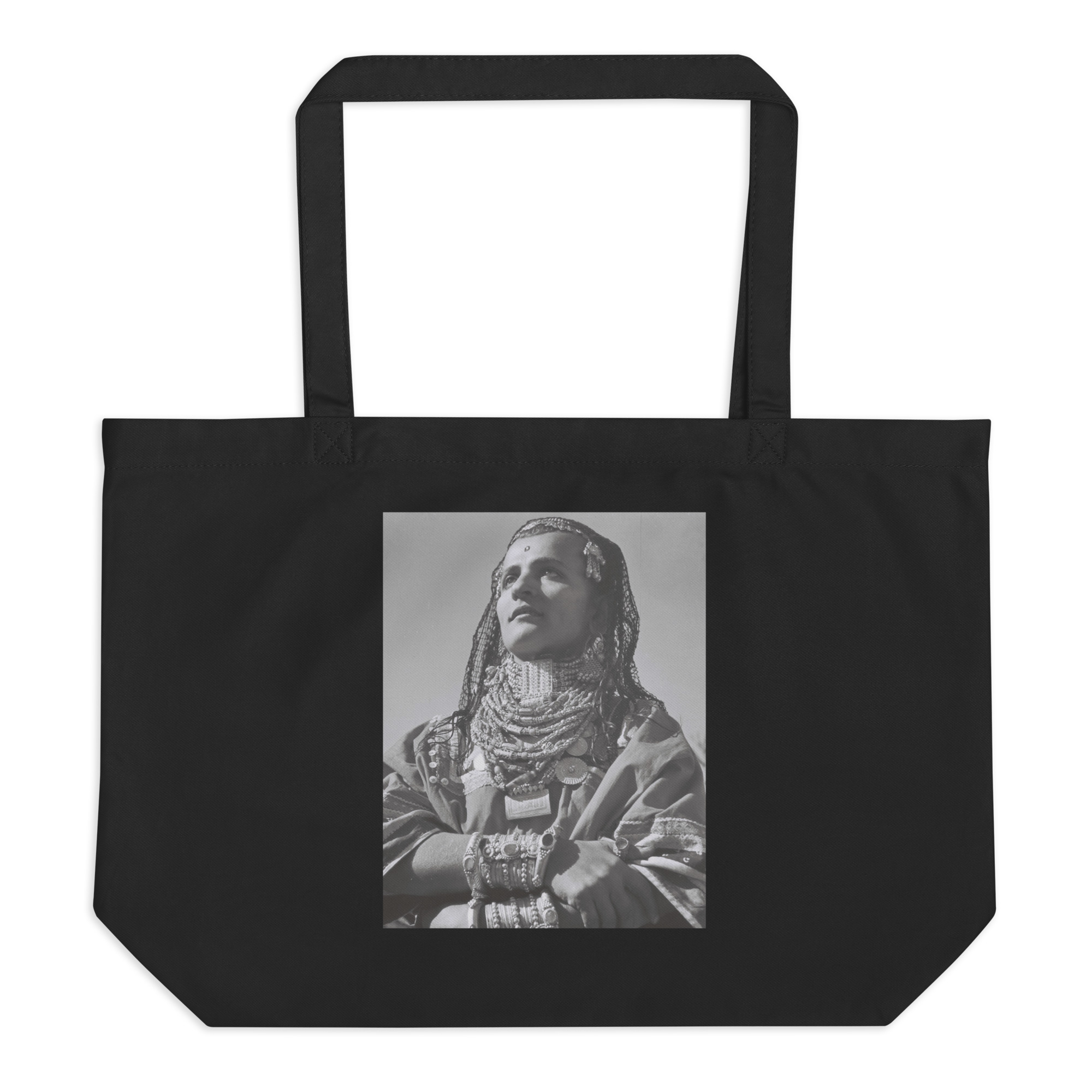7 Questions for Hannah Lupton Reinhard
L.A.-based Jewish painter, Hannah Lupton Reinhard, explores Jewish femininity through vibrant colors studded with Swarovski crystals. Her first solo show in New York City, Shekinah, Shiksas, And Other Nice Jewish Girls, opened in Spring of 2023 at Fredericks & Freiser. Her work can be found in the collection of ICA Miami and has been included in exhibitions at Loyal Gallery, Stockholm; Analog Diary, New York; Unit London; Bill Brady, Los Angeles; and Carl Kostyál, Stockholm. JWA recently sat down with the artist to discuss her work.
Emma Breitman: What does Jewishness mean to you?
Hannah Lupton Reinhard: To me, being Jewish is about community. Of course, there are individual aspects of my Judaism, like the daily choice to keep Kosher or davening on Yom Kippur. But even on Yom Kippur, the most important aspect of it has become spending it with my sister. Since 2021, we’ve both been living in Los Angeles, and although it’s not very far from home, we choose to stay here together and have found a local synagogue we like, sometimes going to the beach after services, and then hosting a little break-fast at one of our houses with a few Jewish and non-Jewish friends.
I’m not particularly religious in the traditional sense, so the actual services on Yom Kippur aren’t as important to me as carving out that day to be away from the world, reflect, and talk about life with my sister. Opening my home to my Jewish and non-Jewish friends is a huge part of Judaism for me. Introducing my shiksah besties to all of the warm and special Jewish rituals, holidays, and foods has been so important to me. I love creating an open space where everyone feels included without feeling indoctrinated. I see it as being a key part of living in Diaspora, or living amongst non-Jews. My Judaism is richer and fuller with my non-Jewish friends; it doesn’t flourish in spite of them, but often because of them.
EB: How do you seek to engage with Jewishness in your art practice?
HLR: When I was finishing up art school in May of 2020, I was living at home with my whole family for the first time in years, and my world became very small. I began making portraits of my sisters engaging in various rituals like lighting the havdalah candle or eating apples and honey for the New Year. In school, I had been painting packed and lively party scenes of my friends, using imagery taken from the rowdy Shabbat parties I used to host. It was your typical Friday night party, until I’d interrupt to quickly silence everyone as I blessed the candles, wine, and challah. So these Jewish party scenes had been the subject matter of my work, but during COVID, it didn’t make sense to paint big social scenes like that anymore. I really began focusing on portraiture and exploring the faces of the different women in my life, while using Jewish ritual and identity almost as a backdrop.
I often explore Biblical scenes and themes, Sodom and Gomorrah being one that keeps drawing me back in. I’ve used ribbons to allude to tiffilin, braided hair to suggest challah, headscarves to signify modesty, and scented candles to represent those of Shabbat. As the paintings have developed, they are less and less obviously linked to Judaism. I want them to be universal and able to speak to and about all types of people, while still feeling inherently and almost secretly Jewish. Just like the rest of my life, Judaism informs my paintings, but isn’t necessarily the main character, determining or controlling either.
EB: I've seen you describe your work as "fantasy realism." How do you see that playing out?
HLR: I describe my paintings as fantasy realism because they’re images of women taken from my real life, but through color and often in epic landscapes, they take on a more fantastical feeling. I see the subjects as actors playing a character. Each portrait is of a real person in my life, but isn’t necessarily about them or limited to them. I try to make the paintings both embody and transcend their actual subjects. They become as much about the surfaces felt, colors seen, and feelings invoked when you stand in front of them as they are about the particular models or scenes. They feel close to us, yet slightly removed from our world. I don’t see “fantasy” as an escape from reality, but as a way into a deeper experience of what is most real.
EB: Can you share a bit about the history of crystal in your family and its presence in your work?
HLR: Some of my most vivid memories from my grandparents’ house involve tall white cabinets in their kitchen, filled with crystal beads. My bubbie, whose parents left Russia around the turn of the century, made beaded Swarovski jewelry which she sold at Saks Fifth Avenue. I’m not sure if every little girl had such magpie-like desires as I did, but the allure of the sparkling crystal beads was intoxicating to me. I used to spend afternoons there with her stringing wire through beads. I think this child-like desire for sparkly objects is something that has stuck with me as an adult, and it often feels as if my great quest in life is to figure out how to embed sparkles into my world. At RISD, I gained access to a small stockroom of Swarovski crystals that had been donated to the school, and began incorporating them into my paintings. When I graduated and moved to Los Angeles, I happened to get a studio in the heart of Downtown’s fashion district, giving me further access and proximity to Swarovski crystals and rhinestones. The crystals seem to follow me around at this point and continue to be a facet of my work and life.
The paintings, in a lot of ways, are about light, and the crystals bring actual refracted light into the experience of viewing the work. I see the rhinestones as being tongue-in-cheek, making the paintings feel both more and less valuable. The precision and slow labor it takes to embellish the work with each crystal highlights a seriousness to the craft. But the crafty element itself also makes the work feel less serious than a traditional oil painting. I think the push and pull between high and low art that the rhinestones create, while being a not-so-subtle nod at femininity and girlhood, adds an important tension to the paintings.
EB: Your work makes use of vibrant colors while often depicting solemn, feminine figures. What role does color play in your exploration of femininity?
HLR: The figures in my work are often melancholy, even though they’re painted in such a technicolor palette. They often gaze at the viewer with a sort of knowing seriousness, like they understand something we don’t or have some kind of secret they won’t share with us. Or they look elsewhere, refusing to engage with us at all. On the surface, they’re bright and sparkly, but while their visual loudness draws the viewer in, they reveal themselves to be more than just colorful. The figures demand to be taken seriously, as sources of withheld truths, even though they’re bright and embellished, and seem to reflect the superficial aspect of the feminine experience.
EB: Are there any Jewish histories, rituals, or experiences that have felt especially influential to your work?
HLR: There are many Jewish motifs and subjects that I’ve been drawn to when making the work. Miriam is a character I’ve depicted in many paintings, as she’s seen as a protector but also a symbol of song and celebration. Over the years, the head scarf has been a major motif, acting as both a simplistic representation of modesty (often countered by some element of immodesty) and as a visual reference to the Old World, perhaps a pre-war Yiddish shtetl. The “babushka” feeling of the head scarf has come to represent a kind of fantasy Jewish Utopia where Jews live happily in the European Diaspora and nothing bad happens. (Read Philip Roth’s Operation Shylock for more on this…). The candle has also been a major motif in my work, representing both the feminine role of lighting and blessing the candles on Shabbat, as well as the Yahrzeit candle. Candles also have an important ritual function in many cultures and religions around the world, so they function both as a universal symbol and a culturally specific one.
EB: As your career continues, are there any concepts or themes you want to explore in more detail?
HLR: I’ve been thinking a lot about Biblical fires (Sodom and Gomorrah) and floods (Noah’s ark), and other ancient representations of disaster. Today (as in many moments in the past), there seems to be a general feeling that the end of the world is imminent, and these themes feel poignant now more than ever. With the advent of AI and other artificial ways of making art, I remain steadfast in my use of real women in my life as well as the slow and methodical use of the human hand, which will perhaps become more and more foreign in the types of images we consume.
It can be hard to make paintings in a time when so much bad stuff is happening all over the world. I feel useless and silly sometimes. But making work that people can connect with on a deep and visceral level is, I believe, a valiant pursuit. My paintings are not just fantastic escapes from the dark reality we find ourselves in today, but openings to a better world that, I believe, is available to us if we can create it. So as I move forward, themes of apocalypse but also utopia, and perhaps both at once, will remain key elements of my work. Surface, texture, and color are also formal elements that I want to keep expanding on and exploring, as physical objects become more and more precious. Lastly, I want to keep making work that is derived from but not limited to my Jewish identity, values, and history: work that locates that identity in a larger world.

